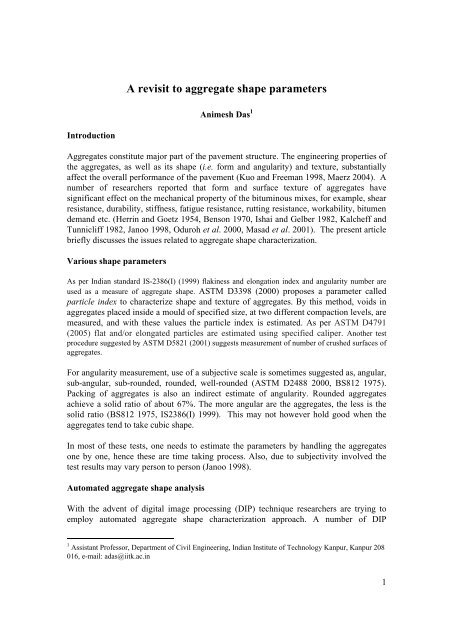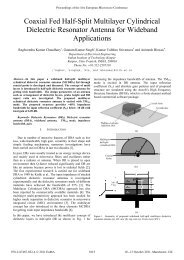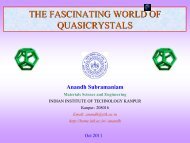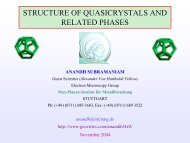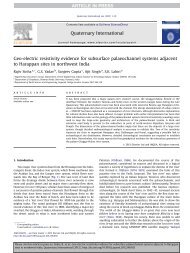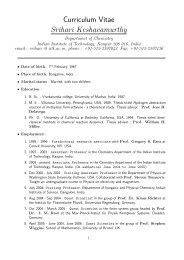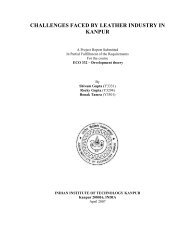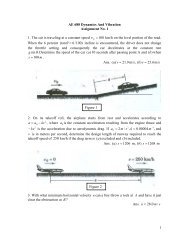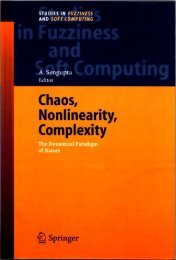A revisit to aggregate shape parameters - iitk.ac.in - Indian Institute ...
A revisit to aggregate shape parameters - iitk.ac.in - Indian Institute ...
A revisit to aggregate shape parameters - iitk.ac.in - Indian Institute ...
You also want an ePaper? Increase the reach of your titles
YUMPU automatically turns print PDFs into web optimized ePapers that Google loves.
Introduction<br />
A <strong>revisit</strong> <strong>to</strong> <strong>aggregate</strong> <strong>shape</strong> <strong>parameters</strong><br />
Animesh Das 1<br />
Aggregates constitute major part of the pavement structure. The eng<strong>in</strong>eer<strong>in</strong>g properties of<br />
the <strong>aggregate</strong>s, as well as its <strong>shape</strong> (i.e. form and angularity) and texture, substantially<br />
affect the overall performance of the pavement (Kuo and Freeman 1998, Maerz 2004). A<br />
number of researchers reported that form and surf<strong>ac</strong>e texture of <strong>aggregate</strong>s have<br />
significant effect on the mechanical property of the bitum<strong>in</strong>ous mixes, for example, shear<br />
resistance, durability, stiffness, fatigue resistance, rutt<strong>in</strong>g resistance, workability, bitumen<br />
demand etc. (Herr<strong>in</strong> and Goetz 1954, Benson 1970, Ishai and Gelber 1982, Kalcheff and<br />
Tunnicliff 1982, Janoo 1998, Oduroh et al. 2000, Masad et al. 2001). The present article<br />
briefly discusses the issues related <strong>to</strong> <strong>aggregate</strong> <strong>shape</strong> char<strong>ac</strong>terization.<br />
Various <strong>shape</strong> <strong>parameters</strong><br />
As per <strong>Indian</strong> standard IS-2386(I) (1999) flak<strong>in</strong>ess and elongation <strong>in</strong>dex and angularity number are<br />
used as a measure of <strong>aggregate</strong> <strong>shape</strong>. ASTM D3398 (2000) proposes a parameter called<br />
particle <strong>in</strong>dex <strong>to</strong> char<strong>ac</strong>terize <strong>shape</strong> and texture of <strong>aggregate</strong>s. By this method, voids <strong>in</strong><br />
<strong>aggregate</strong>s pl<strong>ac</strong>ed <strong>in</strong>side a mould of specified size, at two different comp<strong>ac</strong>tion levels, are<br />
measured, and with these values the particle <strong>in</strong>dex is estimated. As per ASTM D4791<br />
(2005) flat and/or elongated particles are estimated us<strong>in</strong>g specified caliper. Another test<br />
procedure suggested by ASTM D5821 (2001) suggests measurement of number of crushed surf<strong>ac</strong>es of<br />
<strong>aggregate</strong>s.<br />
For angularity measurement, use of a subjective scale is sometimes suggested as, angular,<br />
sub-angular, sub-rounded, rounded, well-rounded (ASTM D2488 2000, BS812 1975).<br />
P<strong>ac</strong>k<strong>in</strong>g of <strong>aggregate</strong>s is also an <strong>in</strong>direct estimate of angularity. Rounded <strong>aggregate</strong>s<br />
<strong>ac</strong>hieve a solid ratio of about 67%. The more angular are the <strong>aggregate</strong>s, the less is the<br />
solid ratio (BS812 1975, IS2386(I) 1999). This may not however hold good when the<br />
<strong>aggregate</strong>s tend <strong>to</strong> take cubic <strong>shape</strong>.<br />
In most of these tests, one needs <strong>to</strong> estimate the <strong>parameters</strong> by handl<strong>in</strong>g the <strong>aggregate</strong>s<br />
one by one, hence these are time tak<strong>in</strong>g process. Also, due <strong>to</strong> subjectivity <strong>in</strong>volved the<br />
test results may vary person <strong>to</strong> person (Janoo 1998).<br />
Au<strong>to</strong>mated <strong>aggregate</strong> <strong>shape</strong> analysis<br />
With the advent of digital image process<strong>in</strong>g (DIP) technique researchers are try<strong>in</strong>g <strong>to</strong><br />
employ au<strong>to</strong>mated <strong>aggregate</strong> <strong>shape</strong> char<strong>ac</strong>terization appro<strong>ac</strong>h. A number of DIP<br />
1 Assistant Professor, Department of Civil Eng<strong>in</strong>eer<strong>in</strong>g, <strong>Indian</strong> <strong>Institute</strong> of Technology Kanpur, Kanpur 208<br />
016, e-mail: adas@<strong>iitk</strong>.<strong>ac</strong>.<strong>in</strong><br />
1
techqniues, such as X-ray <strong>to</strong>mography, laser profil<strong>in</strong>g and pho<strong>to</strong>grammetry have been<br />
tried (Kim et al. 1992, Kuo et al. 1996, Kuo and Freeman 1998, Yue et al. 1995, Yue and<br />
Mor<strong>in</strong> 1996). This appro<strong>ac</strong>h has the follow<strong>in</strong>g advantages:<br />
• The method is fast and therefore can be applied as real-time quality control (Maerz<br />
2004) and, <strong>ac</strong>cord<strong>in</strong>gly, adjustments can be applied on <strong>to</strong> crusher or sieves.<br />
• S<strong>in</strong>ce this method is au<strong>to</strong>mated, it is free from subjectivity associated with human<br />
judgment.<br />
• S<strong>in</strong>ce a large number of samples can be tested, and the statistical reliability is<br />
expected <strong>to</strong> be enhanced.<br />
• With the application this technique, various other geometrical features of <strong>aggregate</strong>s,<br />
viz., area, cross-section, perimeter, orientation, the size distribution and even the mix<br />
volumetric <strong>parameters</strong> can be measured.<br />
Interest<strong>in</strong>gly, follow<strong>in</strong>g fresh issues evolve with the DIP technique with reference <strong>to</strong> the<br />
conventional <strong>shape</strong> <strong>parameters</strong> (Kwan et al. 1999, Mora and Kwan 2000):<br />
• Most of the time, DIP technique captures a two dimensional (2-D) image (or shadow)<br />
of the <strong>aggregate</strong>s, and it is difficult <strong>to</strong> perform 3-D imag<strong>in</strong>g <strong>to</strong> obta<strong>in</strong> the third<br />
dimension. Though, some researchers have successfully measured the volume of the<br />
<strong>aggregate</strong>s, by tak<strong>in</strong>g orthogonal views (Rao and Tutumluer 2000), most of the time<br />
DIP <strong>parameters</strong> are obta<strong>in</strong>ed as area fr<strong>ac</strong>tion and not as volume fr<strong>ac</strong>tion. Thus, by<br />
us<strong>in</strong>g DIP technique, it is difficult <strong>to</strong> measure the <strong>shape</strong> <strong>parameters</strong> <strong>in</strong> terms of weight<br />
or volume, as is generally followed <strong>in</strong> conventional <strong>shape</strong> <strong>parameters</strong>.<br />
• The conventional <strong>shape</strong> <strong>parameters</strong> like, flak<strong>in</strong>ess <strong>in</strong>dex and elongation <strong>in</strong>dex are<br />
char<strong>ac</strong>terized with reference <strong>to</strong> the slot sizes. This size is neither the length, or, width<br />
or, height of the <strong>aggregate</strong>s measured by the DIP technique, which uses a ‘box<br />
pr<strong>in</strong>ciple’ <strong>to</strong> circumscribe the <strong>aggregate</strong>s (Maerz 2004). It is, therefore, difficult <strong>to</strong><br />
obta<strong>in</strong> the conventional flak<strong>in</strong>ess or elongation values of <strong>aggregate</strong>s by us<strong>in</strong>g DIP<br />
technique.<br />
Thus, while attempt<strong>in</strong>g <strong>to</strong> char<strong>ac</strong>terize <strong>aggregate</strong> <strong>shape</strong>, the researchers were prompted <strong>to</strong><br />
use various <strong>shape</strong> <strong>parameters</strong>, other than the conventional ones. Table-1 compiles a<br />
partial list of various such <strong>shape</strong> <strong>parameters</strong>.<br />
Table-1 Def<strong>in</strong>itions of various DIP based <strong>shape</strong> <strong>parameters</strong><br />
Parameter Def<strong>in</strong>ition References<br />
Elongation length<br />
width<br />
Kuo et al. 1998<br />
Flatness width<br />
thickness<br />
Kuo et al. 1998<br />
Flak<strong>in</strong>ess thickness<br />
breadth<br />
Barksdale et al. 1991<br />
Sphericity<br />
3 thickness × width<br />
2<br />
length<br />
Barksdale et al. 1991<br />
2
Shape f<strong>ac</strong><strong>to</strong>r thickness<br />
length × width<br />
Barksdale et al. 1991, Yue et<br />
al. 1995, Kuo et al. 1996<br />
Form f<strong>ac</strong><strong>to</strong>r 4π<br />
× area<br />
2<br />
perimeter<br />
Kuo et al. 1998<br />
Roughness perimeter Kuo et al. 1998<br />
π × average diameter<br />
Convexity ratio projected area<br />
convex area<br />
Mora and Kwan 2000<br />
Fullness ratio convexity ratio<br />
Mora and Kwan 2000<br />
These <strong>parameters</strong> are developed us<strong>in</strong>g simple geometrical pr<strong>in</strong>ciples, <strong>in</strong>scrib<strong>in</strong>g or<br />
circumscrib<strong>in</strong>g an <strong>aggregate</strong> with some regular geometric <strong>shape</strong>, and then compar<strong>in</strong>g the<br />
surf<strong>ac</strong>e area or the volume. The expressions of these <strong>parameters</strong> are not fixed, various<br />
alternative expressions (Janoo 1998) are proposed and used by the various researchers.<br />
Similarly, for quantify<strong>in</strong>g angularity as a <strong>shape</strong> parameter, researchers have suggested<br />
various criteria (Yudhbir and Abed<strong>in</strong>zadeh 1991, Mora and Kwan 2000, Rao et al. 2002,<br />
Chandan et al. 2004) for example, (i) the corner angle (ii) height of corner (iii) radius of<br />
curvature of corner (iv) concavity or convexivity of corner etc.<br />
Clos<strong>in</strong>g remarks<br />
It appears that the DIP based method of <strong>aggregate</strong> <strong>shape</strong> char<strong>ac</strong>terization is an emerg<strong>in</strong>g<br />
area, <strong>to</strong> estimate <strong>aggregate</strong> <strong>shape</strong> (as well as mix volumetric <strong>parameters</strong>) quickly and<br />
reliably. DIP method has also been used <strong>in</strong> <strong>shape</strong> char<strong>ac</strong>terization of f<strong>in</strong>e <strong>aggregate</strong>s and<br />
texture analysis. This method has, therefore, a potential application <strong>in</strong> real-time quality<br />
control dur<strong>in</strong>g mix manuf<strong>ac</strong>tur<strong>in</strong>g. It is anticipated that this technique will tend <strong>to</strong> use<br />
fresh set of <strong>shape</strong> <strong>parameters</strong> than the conventional ones. Thus, there is a need <strong>to</strong> gather<br />
performance data of the mix with reference <strong>to</strong> these DIP based <strong>shape</strong> <strong>parameters</strong> (Kuo et<br />
al. 1998).<br />
References<br />
ASTM D 2488, Standard pr<strong>ac</strong>tice for description and identification of soils (visual-manual<br />
procedure, ASTM, West Conshohocken, 2000.<br />
ASTM D3398, Standard test method for <strong>in</strong>dex of <strong>aggregate</strong> particle <strong>shape</strong> and texture, ASTM,<br />
West Conshohocken, 2000.<br />
ASTM D4791, Standard test method for flat particles, elongated particles, or flat and elongated<br />
particles <strong>in</strong> coarse <strong>aggregate</strong>, ASTM, West Conshohocken, 2005.<br />
ASTM D5821, Standard test method for determ<strong>in</strong><strong>in</strong>g the percentage of fr<strong>ac</strong>tured particles <strong>in</strong><br />
coarse <strong>aggregate</strong>, ASTM, West Conshohocken, 2001.<br />
Barksdale, R. D., Kemp, M. A., Sheffield, W. J., Hubbard, J. L., “Measurement of <strong>aggregate</strong><br />
<strong>shape</strong>, surf<strong>ac</strong>e area, and roughness”, Transportation Research Record, No. 1301, National<br />
Research Council, Wash<strong>in</strong>g<strong>to</strong>n, D.C., 1991, pp.107-116.<br />
3
Benson, F. J., “Effects of <strong>aggregate</strong> size, <strong>shape</strong>, and surf<strong>ac</strong>e texture on the properties of<br />
bitum<strong>in</strong>ous mixtures – a literature survey”, Special Report 109, HRB, National Research<br />
Council, Wash<strong>in</strong>g<strong>to</strong>n, D. C., 1970, pp.12-22.<br />
BS812 Part 1, Sampl<strong>in</strong>g and test<strong>in</strong>g of m<strong>in</strong>eral <strong>aggregate</strong>s, sands and fillers, British Standards<br />
Institution, 1975, London.<br />
Chandan, C., Sivakumar, K., Masad, E. and Fletcher, T., “Application of imag<strong>in</strong>g techqniues <strong>to</strong><br />
geometry analysis of <strong>aggregate</strong> particles”, Journal of comput<strong>in</strong>g <strong>in</strong> Civil Eng<strong>in</strong>eer<strong>in</strong>g, ASCE,<br />
Vol.18(1), 2004, pp.75-82.<br />
Herra<strong>in</strong>, M. and Goetz., W. H. “Effect of <strong>aggregate</strong> <strong>shape</strong> on stability of bitum<strong>in</strong>ous mixes”,<br />
HRB Proc., Vol. 33, 1954, pp.293-308.<br />
IS 2386(I), <strong>Indian</strong> standard methods of test for <strong>aggregate</strong>s for concrete, Part-I: particle size and<br />
<strong>shape</strong>, The Bureau of <strong>Indian</strong> Standards, New Delhi, 12th repr<strong>in</strong>t, 1999.<br />
Ishai, I. and Gelber, H., “Effect of geometric irregularity of <strong>aggregate</strong>s on the properties and<br />
behaviour of bitum<strong>in</strong>ous concrete”, Proc. of AAPT, Vol. 51, 1982.<br />
Janoo, V. C., “Quantification of <strong>shape</strong>, angularity, and surf<strong>ac</strong>e texture of base course materials”,<br />
CRREL Special Report No. 98-1, Cold Regions Research and Eng<strong>in</strong>eer<strong>in</strong>g Labora<strong>to</strong>ry, USA,<br />
1998.<br />
Kalcheff, I. V. and Tunnicliff, D. G., “Effects of crushed s<strong>to</strong>ne <strong>aggregate</strong> size and <strong>shape</strong> on<br />
properties of asphalt concrete”, Proc. of AAPT, Vol. 51, 1982.<br />
Kim, Y. R., Yim, N., and Khosla, N. P. “Effect of <strong>aggregate</strong> type and gradation on fatigue and<br />
permanent deformation of asphalt concrete” ASTM STP 1147, Philadelphia, 1992, 310-328.<br />
Kuo, C-Y., and Freeman, R. B., “Image analysis evaluation of <strong>aggregate</strong>s for asphalt concrete<br />
mixtures”, Transportation Research Record, No. 1615, TRB, National Research Council,<br />
Wash<strong>in</strong>g<strong>to</strong>n, D. C., 1998, pp.65-71.<br />
Kuo, C-Y., Frost, J. D., Lai, J. S., Wang, L. B., “Three-dimensional image analysis of <strong>aggregate</strong><br />
particles from orthogonal projections”, Transportation Research Record, No. 1526, National<br />
Research Council, Wash<strong>in</strong>g<strong>to</strong>n, D.C., 1996, pp. 98-103.<br />
Kuo, C-Y., Roll<strong>in</strong>gs, R. S., and Lynch, L. N., “Morphological study of coarse <strong>aggregate</strong>s us<strong>in</strong>g<br />
image analysis, Journal of Materials <strong>in</strong> Civil Eng<strong>in</strong>eer<strong>in</strong>g, ASCE, 10(3), 1998, pp.135-142.<br />
Kwan, A. K. H., Mora, C. F., Chan, H. C., “Particle <strong>shape</strong> analysis of coarse <strong>aggregate</strong> us<strong>in</strong>g<br />
digital image process<strong>in</strong>g”, Cement and Concrete Research, Cem. Concr. Res., 29 (9), 1999, pp.<br />
1403-1410.<br />
Maerz, N. H., “Technical and computational aspects of the measurement of <strong>aggregate</strong> <strong>shape</strong> by<br />
digital image analysis, Journal of Comput<strong>in</strong>g <strong>in</strong> Civil Eng<strong>in</strong>eer<strong>in</strong>g, ASCE, Vol.18(1), 2004,<br />
pp.10-18.<br />
Masad, E., Olcott, D., White, T. and Tashman, L., “Correlation of f<strong>in</strong>e <strong>aggregate</strong> imag<strong>in</strong><strong>in</strong>g<br />
<strong>shape</strong> <strong>in</strong>dices with asphalt mixture performance”, Transportation Research Record, No. 1757,<br />
TRB, National Research Council, Wash<strong>in</strong>g<strong>to</strong>n D. C., 2001, pp.148-156.<br />
4
Mora, C. F. and Kwan, A. K. H., Sphericity, <strong>shape</strong> f<strong>ac</strong><strong>to</strong>r, and convexity measurement of coarse<br />
<strong>aggregate</strong>s for concrete us<strong>in</strong>g digital image process<strong>in</strong>g, Cement and Concrete Research, No. 30,<br />
2000, pp.351-358.<br />
Oduroh, P. K., Mahboub, K. C., and Anderson, R. M., “Flat and elongated <strong>aggregate</strong>s <strong>in</strong><br />
Superpave regime”, Journal of Materials <strong>in</strong> Civil Eng<strong>in</strong>eer<strong>in</strong>g, ASCE, 2000, 12, pp.124-130.<br />
Rao, C., and Tutumluer, E., “A New Image Analysis Appro<strong>ac</strong>h for the Determ<strong>in</strong>ation of Volume<br />
of Aggregates,” Transportation Research Record, No. 1721, Wash<strong>in</strong>g<strong>to</strong>n D. C., 2000, pp.73-80.<br />
Rao, C., Tutumluer, E., and Kim, I. “Quantification of coarse <strong>aggregate</strong> angularity based on<br />
image analysis,” Transportation Research Record, No. 1787, Wash<strong>in</strong>g<strong>to</strong>n D. C., 2002, pp.117-<br />
124.<br />
Yudhbir and Abed<strong>in</strong>zadeh, R. Quantification of particle <strong>shape</strong> and angularity us<strong>in</strong>g the image<br />
analyzer, ASTM Geotech Test J. Vol.14 (3) , 1991, pp.296- 308.<br />
Yue, Z. Q., Bekk<strong>in</strong>g, W. and Mor<strong>in</strong>, I., “Application of digital image process<strong>in</strong>g <strong>to</strong> quantitative<br />
study of asphalt concrete micro-structure”, Transportation Research Record, 1492, TRB,<br />
National Research Council, Wash<strong>in</strong>g<strong>to</strong>n, D. C., 1995, pp.53-60.<br />
Yue, Z. Q., and Mor<strong>in</strong>, I. “Digital image process<strong>in</strong>g for <strong>aggregate</strong> orientation <strong>in</strong> asphalt concrete<br />
mixtures”, Can J Civil Eng, No. 23, 1996, pp. 480-489.<br />
5


